Cracking Good Recipes
The Good News for Egg Lovers
More Australians are taking an interest in nutrition and health than ever before. Knowledge in nutrition is continually improving with research being conducted at many centres and it is not uncommon for new research findings on foods to contradict older information. Eggs - once thought to be a harmful cholesterol-raising food have now been found to have no effect on people with normal blood cholesterol levels.
Why are eggs a good food?
· High in Protein: Eggs have the ideal protein mix for growth and repair
· Low in fat: A medium egg has less than five grams of fat and is not high in kilojoules
· Low in saturated fat: Eggs have less than 2 grams saturated fat.
· Rich in vitamins: Eggs really are nature's vitamin capsule containing all the vitamins except vitamin C. They are a good source of vitamin B12 which may be lacking in vegetarian diets
· Rich in Iron: Iron is best absorbed from food when Vitamin C is also present so combine your egg with a glass of orange juice for even better nutrition
· Eating 2 eggs per day will not increase LDL (bad) blood cholesterol for people with a normal blood cholesterol level
· Eggs are an ideal food as an alternative to meat
· Eggs are very economical and nutritious
· Reducing saturated fat is far more important than dietary cholesterol reduction
Myths about Eggs
· Eggs and Cholesterol - Until recently it was thought that cholesterol in food was an important factor in high blood cholesterol. We now know that dietary cholesterol alone is not significant for most people. The body produces cholesterol in the liver especially when the diet is high in saturated fat. Research done at the CSIRO's Division of Human Nutrition has shown that cholesterol in diet is far less important than many people think. The research showed that adding two eggs a day to the diet of people with normal cholesterol levels produced no rise in the level of LDL (or bad) cholesterol. Even at three eggs a day, the effect on blood cholesterol was equivalent to eating a pat (10g) of butter or 30g of cheese. So, if saturated fat and not cholesterol is the most important dietary contributor to heart disease shouldn't you be taking advantage of the benefits of eggs?
· Eggs and Fat - Saturated fat from food is the main culprit when it comes to managing blood cholesterol levels. When too much saturated fat is consumed, the body has more trouble balancing the correct amount of cholesterol in the bloodstream. This means that blood cholesterol levels can rise. Healthy fats on the other hand, can help the body remove cholesterol from the bloodstream. These types of fat are good to eat regularly. Healthy fats are called polyunsaturated and monounsaturated and they're found in oils like olive, canola, peanut, sunflower and soybean oil. They are also found in avocadoes, nuts, seeds and fish. It may surprise you to know that of the moderate amount of fat found in eggs, 70% is the healthy type! The good news about eggs and cholesterol means they can be enjoyed regularly as part of a healthy eating pattern. Recent research shows regular egg consumption has other health benefits such as superior nutrient intake
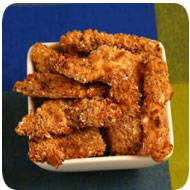
Ingredients
400g chicken breast fillet, skinless
1 Sunny Queen Natural Grain Cage Free egg
1/2 cup skim milk
1 cup flour
1/2 cup multigrain bread crumbs
1/2 cup minute oats
Method:
1. Slice chicken into bite size pieces.
2. Mix the Sunny Queen Natural Grain Cage Free egg with the skim milk.
3. Pop the flour in a plastic bag with the chicken pieces and shake well, ensuring the chicken is completely coated.
4. In a separate bowl, mix the bread crumbs with the oats.
5. One by one, place chicken pieces first into the Sunny Queen Natural Grain Cage Free egg mixture, and then into the crumb and oats mix, covering each side.
6. Place on a baking tray lined with baking paper and cook in a moderate oven for 12-15 minutes or until crunchy.
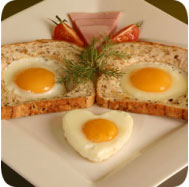
Ingredients
4 Sunny Queen Natural Grain Cage Free eggs
4 slices multigrain bread
2 tomatoes, halved
2 slices of lean ham
Method:
1. Using an upturned glass as a guide, cut a hole out of the middle of each slice of bread.
2. Bring your fry pan to a moderate heat. Place tomato in pan with the sliced side down. Also place the bread rounds that you made previously in the pan.
3. Spray the pan with a little oil. Place the bread slices in the pan and crack a Sunny Queen Natural Grain Cage Free egg in the middle of each slice.
4. Cook until the white of the egg is cooked and the yolk is cooked to your preference. You can turn them over if you wish.
5. Serve on individual plates with half a tomato and half a slice of ham.
6. You can also buy shaped egg rings to make it more interesting.
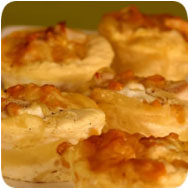
Ingredients
200g fettuccine
200g corn kernels
1 skinless chicken breast, cooked
5 Sunny Queen Natural Grain Cage Free eggs
1 tbsp skim milk
1/4 cup reduced fat cheddar cheese, grated
Black pepper
Method:
1. Cook fettuccine according to packet directions. Cool.
2. Grill or steam chicken breast. Alternatively, leftover barbeque chicken is ideal.
3. Lightly spray muffin trays with oil and line with pasta, followed by chicken and corn.
4. In a large bowl, mix the Sunny Queen Natural Grain Cage Free eggs with the corn, milk and cheese.
5. Pour egg mixture over chicken and sprinkle with ground black pepper.
6. Bake at 180 degrees for 25 minutes until set.
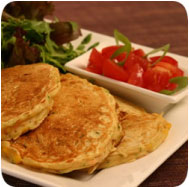
Ingredients
200g self raising flour
1 cup skim milk
2 Sunny Queen Natural Grain Cage Free eggs
1 onion, diced
1/2 cup of grated carrot
1/2 cup grated zucchini
150g corn kernels
2 tbsp fresh herbs, chopped
Method:
1. Place flour in a large bowl and whisk in the milk, followed by two Sunny Queen Natural Grain Cage Free eggs.
2. Fold through remaining ingredients - you can use almost any leftovers you have in the fridge, even last night's roast is a welcome addition.
3. Heat a non-stick fry pan to medium heat, spray lightly with oil and pour in the batter to form individual fritters. When the fritters start to cook, turn them over to complete cooking the underside.
4. These are delicious cold or reheated in the microwave. They also freeze well.
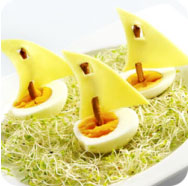
Ingredients
2 Sunny Queen Natural Grain Cage Free eggs, hard boiled
2 slices processed cheese
4 pretzels
Method:
1. Peel the hard boiled Sunny Queen Natural Grain Cage Free eggs.
2. With a sharp knife, slice eggs in half lengthways.
3. Pierce the white of the egg at the top with the pointy end of a knife and poke the end of the pretzel into it.
4. Thread the cheese triangle onto the pretzel to form the sail.
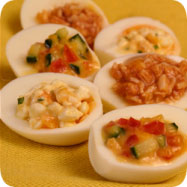
1. Cut shelled, hard boiled Natural Grain Cage Free eggs in half lengthwise.
2. Remove the yolk and mash thoroughly.
3. Refill the hole with the mashed yolks combined with one of the following suggestions (not too much - remember the hole is only small):
· Cottage cheese and chives
· Finely chopped chicken with tomato sauce
· Chopped cucumber with tomato and mayonnaise
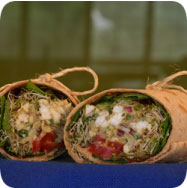
Ingredients
1 piece of wholemeal lavash bread
1 tbs light cream cheese
1/2 cup shredded lettuce
1/2 cup sprouts
1 medium tomato, sliced
1 Sunny Queen Natural Grain Cage Free egg, hard boiled
2 apples
Method:
1. Spread the lavash bread with the cream cheese to help the fillings stay in place.
2. Top cheese with lettuce, sliced tomato and sprouts.
3. Mash up Sunny Queen Natural Grain Cage Free egg with a fork and place over other toppings.
4. Roll up, slice in half and wrap in plastic to keep together. Serve with an apple and a tall glass of water.
Tip: If you are making egg sandwiches for the kids, make them the night before and freeze them. That way they will avoid the aroma of hard boiled eggs in their lunch boxes. Remember though that salad vegetables don't freeze successfully on bread.
Did you know?
· A hen requires approximately 24 hours to produce an egg. Thirty minutes later she starts all over again.
· A yolk makes up 31% of an egg's total weight and is made up of 51% water, 16% protein, 30.5% fat and some minerals. 75% of the egg is water.
· Australians eat more than 3.5 billion eggs a year or 170 per person but egg consumption is highest in Japan, Mexico, Spain and France.
· To test an egg for freshness put the egg in a basin of water. Fresh eggs stay at the bottom of the bowl, while stale eggs stand on end or float because of the large air cell that will have developed inside it.
· An egg will age more in one day at room temperature than in one week kept in the fridge.
· The egg shell may have as many as 17,000 tiny pores over its surface. The egg can absorb flavours and odours through these pores so it is always best to store eggs in their cartons in the fridge.
· If an egg is accidentally dropped on the floor, sprinkle it heavily with salt for easy clean up.
· The Vervain hummingbird lays the smallest egg, about ten millimetres long. The ostrich lays the biggest egg, up to almost 2 kilograms.
· Kiwis have the largest egg-to-body weight ratio of any bird, their eggs averaging about 20% of their body weight. A kiwi about the size of a chicken can lay an egg almost as large as that of an ostrich. An ostrich's egg is about 2% of its body weight.
More Australians are taking an interest in nutrition and health than ever before. Knowledge in nutrition is continually improving with research being conducted at many centres and it is not uncommon for new research findings on foods to contradict older information. Eggs - once thought to be a harmful cholesterol-raising food have now been found to have no effect on people with normal blood cholesterol levels.
Why are eggs a good food?
· High in Protein: Eggs have the ideal protein mix for growth and repair
· Low in fat: A medium egg has less than five grams of fat and is not high in kilojoules
· Low in saturated fat: Eggs have less than 2 grams saturated fat.
· Rich in vitamins: Eggs really are nature's vitamin capsule containing all the vitamins except vitamin C. They are a good source of vitamin B12 which may be lacking in vegetarian diets
· Rich in Iron: Iron is best absorbed from food when Vitamin C is also present so combine your egg with a glass of orange juice for even better nutrition
· Eating 2 eggs per day will not increase LDL (bad) blood cholesterol for people with a normal blood cholesterol level
· Eggs are an ideal food as an alternative to meat
· Eggs are very economical and nutritious
· Reducing saturated fat is far more important than dietary cholesterol reduction
Myths about Eggs
· Eggs and Cholesterol - Until recently it was thought that cholesterol in food was an important factor in high blood cholesterol. We now know that dietary cholesterol alone is not significant for most people. The body produces cholesterol in the liver especially when the diet is high in saturated fat. Research done at the CSIRO's Division of Human Nutrition has shown that cholesterol in diet is far less important than many people think. The research showed that adding two eggs a day to the diet of people with normal cholesterol levels produced no rise in the level of LDL (or bad) cholesterol. Even at three eggs a day, the effect on blood cholesterol was equivalent to eating a pat (10g) of butter or 30g of cheese. So, if saturated fat and not cholesterol is the most important dietary contributor to heart disease shouldn't you be taking advantage of the benefits of eggs?
· Eggs and Fat - Saturated fat from food is the main culprit when it comes to managing blood cholesterol levels. When too much saturated fat is consumed, the body has more trouble balancing the correct amount of cholesterol in the bloodstream. This means that blood cholesterol levels can rise. Healthy fats on the other hand, can help the body remove cholesterol from the bloodstream. These types of fat are good to eat regularly. Healthy fats are called polyunsaturated and monounsaturated and they're found in oils like olive, canola, peanut, sunflower and soybean oil. They are also found in avocadoes, nuts, seeds and fish. It may surprise you to know that of the moderate amount of fat found in eggs, 70% is the healthy type! The good news about eggs and cholesterol means they can be enjoyed regularly as part of a healthy eating pattern. Recent research shows regular egg consumption has other health benefits such as superior nutrient intake

Sunny Queen Natural Grain Cage Free Eggs
Chicken Nuggets
Serves 6Ingredients
400g chicken breast fillet, skinless
1 Sunny Queen Natural Grain Cage Free egg
1/2 cup skim milk
1 cup flour
1/2 cup multigrain bread crumbs
1/2 cup minute oats
Method:
1. Slice chicken into bite size pieces.
2. Mix the Sunny Queen Natural Grain Cage Free egg with the skim milk.
3. Pop the flour in a plastic bag with the chicken pieces and shake well, ensuring the chicken is completely coated.
4. In a separate bowl, mix the bread crumbs with the oats.
5. One by one, place chicken pieces first into the Sunny Queen Natural Grain Cage Free egg mixture, and then into the crumb and oats mix, covering each side.
6. Place on a baking tray lined with baking paper and cook in a moderate oven for 12-15 minutes or until crunchy.

Sunny Side-up
Serves 4Ingredients
4 Sunny Queen Natural Grain Cage Free eggs
4 slices multigrain bread
2 tomatoes, halved
2 slices of lean ham
Method:
1. Using an upturned glass as a guide, cut a hole out of the middle of each slice of bread.
2. Bring your fry pan to a moderate heat. Place tomato in pan with the sliced side down. Also place the bread rounds that you made previously in the pan.
3. Spray the pan with a little oil. Place the bread slices in the pan and crack a Sunny Queen Natural Grain Cage Free egg in the middle of each slice.
4. Cook until the white of the egg is cooked and the yolk is cooked to your preference. You can turn them over if you wish.
5. Serve on individual plates with half a tomato and half a slice of ham.
6. You can also buy shaped egg rings to make it more interesting.

Chicken and Corn Snacks
Serves 6Ingredients
200g fettuccine
200g corn kernels
1 skinless chicken breast, cooked
5 Sunny Queen Natural Grain Cage Free eggs
1 tbsp skim milk
1/4 cup reduced fat cheddar cheese, grated
Black pepper
Method:
1. Cook fettuccine according to packet directions. Cool.
2. Grill or steam chicken breast. Alternatively, leftover barbeque chicken is ideal.
3. Lightly spray muffin trays with oil and line with pasta, followed by chicken and corn.
4. In a large bowl, mix the Sunny Queen Natural Grain Cage Free eggs with the corn, milk and cheese.
5. Pour egg mixture over chicken and sprinkle with ground black pepper.
6. Bake at 180 degrees for 25 minutes until set.

Savoury Fritters
Serves 6Ingredients
200g self raising flour
1 cup skim milk
2 Sunny Queen Natural Grain Cage Free eggs
1 onion, diced
1/2 cup of grated carrot
1/2 cup grated zucchini
150g corn kernels
2 tbsp fresh herbs, chopped
Method:
1. Place flour in a large bowl and whisk in the milk, followed by two Sunny Queen Natural Grain Cage Free eggs.
2. Fold through remaining ingredients - you can use almost any leftovers you have in the fridge, even last night's roast is a welcome addition.
3. Heat a non-stick fry pan to medium heat, spray lightly with oil and pour in the batter to form individual fritters. When the fritters start to cook, turn them over to complete cooking the underside.
4. These are delicious cold or reheated in the microwave. They also freeze well.

Sunny Sail Boats
Serves 4Ingredients
2 Sunny Queen Natural Grain Cage Free eggs, hard boiled
2 slices processed cheese
4 pretzels
Method:
1. Peel the hard boiled Sunny Queen Natural Grain Cage Free eggs.
2. With a sharp knife, slice eggs in half lengthways.
3. Pierce the white of the egg at the top with the pointy end of a knife and poke the end of the pretzel into it.
4. Thread the cheese triangle onto the pretzel to form the sail.

Scrumptious Sunny Lunch Boxes
Placing these shells of goodness in the kids' lunch boxes will please everyone.1. Cut shelled, hard boiled Natural Grain Cage Free eggs in half lengthwise.
2. Remove the yolk and mash thoroughly.
3. Refill the hole with the mashed yolks combined with one of the following suggestions (not too much - remember the hole is only small):
· Cottage cheese and chives
· Finely chopped chicken with tomato sauce
· Chopped cucumber with tomato and mayonnaise

Wrap of Lettuce, Egg and Tomato Sprouts
Serves 2Ingredients
1 piece of wholemeal lavash bread
1 tbs light cream cheese
1/2 cup shredded lettuce
1/2 cup sprouts
1 medium tomato, sliced
1 Sunny Queen Natural Grain Cage Free egg, hard boiled
2 apples
Method:
1. Spread the lavash bread with the cream cheese to help the fillings stay in place.
2. Top cheese with lettuce, sliced tomato and sprouts.
3. Mash up Sunny Queen Natural Grain Cage Free egg with a fork and place over other toppings.
4. Roll up, slice in half and wrap in plastic to keep together. Serve with an apple and a tall glass of water.
Tip: If you are making egg sandwiches for the kids, make them the night before and freeze them. That way they will avoid the aroma of hard boiled eggs in their lunch boxes. Remember though that salad vegetables don't freeze successfully on bread.
Did you know?
· A hen requires approximately 24 hours to produce an egg. Thirty minutes later she starts all over again.
· A yolk makes up 31% of an egg's total weight and is made up of 51% water, 16% protein, 30.5% fat and some minerals. 75% of the egg is water.
· Australians eat more than 3.5 billion eggs a year or 170 per person but egg consumption is highest in Japan, Mexico, Spain and France.
· To test an egg for freshness put the egg in a basin of water. Fresh eggs stay at the bottom of the bowl, while stale eggs stand on end or float because of the large air cell that will have developed inside it.
· An egg will age more in one day at room temperature than in one week kept in the fridge.
· The egg shell may have as many as 17,000 tiny pores over its surface. The egg can absorb flavours and odours through these pores so it is always best to store eggs in their cartons in the fridge.
· If an egg is accidentally dropped on the floor, sprinkle it heavily with salt for easy clean up.
· The Vervain hummingbird lays the smallest egg, about ten millimetres long. The ostrich lays the biggest egg, up to almost 2 kilograms.
· Kiwis have the largest egg-to-body weight ratio of any bird, their eggs averaging about 20% of their body weight. A kiwi about the size of a chicken can lay an egg almost as large as that of an ostrich. An ostrich's egg is about 2% of its body weight.
MORE



